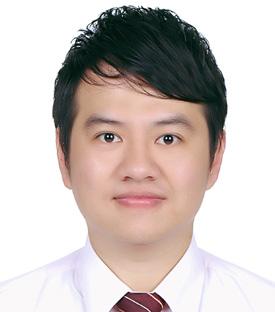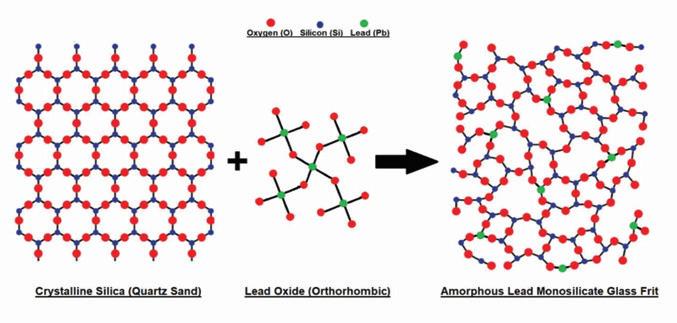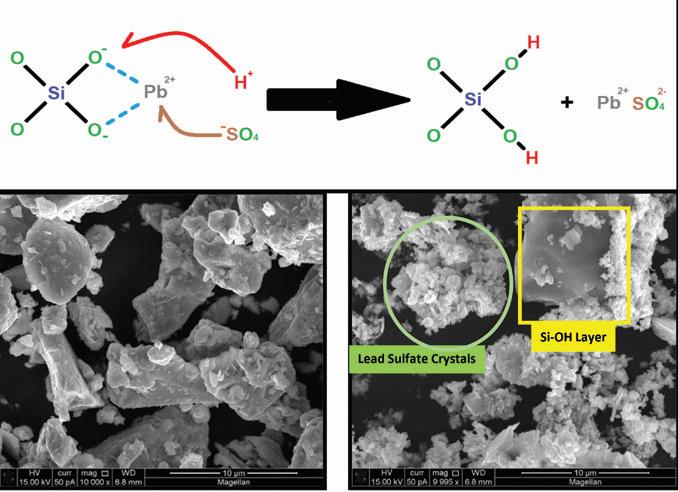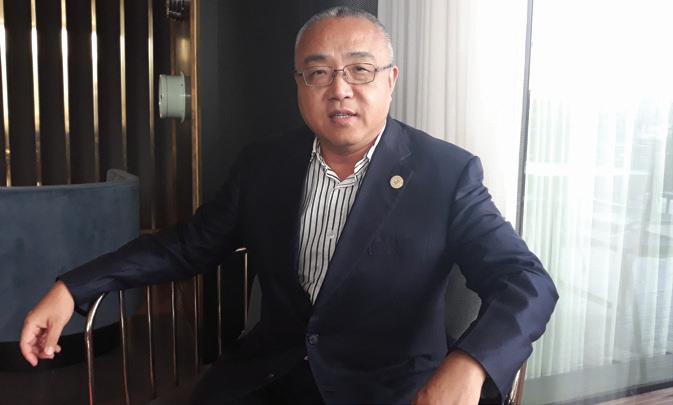
23 minute read
ABC PRESENTATIONS
from 19ABC Showguide
by hamptonhalls
Wednesday 6:50pm
Electrolyte and positive active-mass additives to improve the PSoC cycling endurance of automotive lead acid batteries
Plamen Nikolov, head of Electrochemical Power Sources Department, at the Institute of Electrochemistry and Energy SystemsBAS
The discharge capacity fading of the positive active-mass during PSoC operation has not been well studied. PAM has a complex structure and charge discharge reactions proceed through many elementary processes and phenomena that involve several electrochemically active species and intermediates. The study has evaluated these structural changes during PSoC operation of automotive lead acid batteries: to improve the cycling performance of the PAM, the effect of adding (i) an inorganic phosphorous-containing substance as to the sulfuric acid electrolyte solution and (ii) a clay mineral substance to the positive plate paste.
The studied materials are natural inorganic substances that are environmentally friendly and widely available at low cost. PSoC cycling of flooded-type 2V, 4Ah test cells at 17.5% DoD provokes considerable changes in degree of crystallinity of the beta-PbO2 phase, the content of the alpha-PbO2 phase, the PAM pore volume and surface area, as well as the size and shape of individual PbO2 particles.
The two additives are able to suppress and delay the processes that cause deterioration of the PAM discharge performance. The test cells with the studied additives sustained more than 2,000 cycles. This performance corresponds to a notable two-fold improvement in cycle-life compared with the control cells.

Plamen Nikolov, Institute of Electrochemistry and Energy SystemsBAS
Wednesday 7:15pm
Assessment of carbon blackorganic expander interactions on capacity, dynamic charge acceptance, cold cranking and partial state of charge life of lead acid batteries
Tim McNally, manager R&D, Borregard
This presentation concerns an investigation of the interaction of lignosulfonate expanders Vanisperse A and Vanisperse DCA with eight commercially available carbons. The carbons’ surface-area ranged from 75 m2 g-1 to 1400 m2 g-1. Where a general correlation was established between the carbon specific surface-area and the effective dose, nonlinearities in lignosulfonate adsorption suggested secondary factors, for example carbon surface groups or size exclusion due to carbon pore structure, might also play a role.
Furthermore, the fact that the relative mass of the lignosulfonates adsorbed varied with the carbon suggested that lignosulfonate structure might also influence adsorption. Subsequent battery tests also revealed strong correlations between effective lignosulfonate dose and battery performance, though again the extents of these correlations were complicated by secondary effects or intrinsic lignosulfonate / carbon synergies.
Nevertheless, it can be concluded that the effective dose of lignosulfonate is contingent on the carbon specific surface area and a minimum threshold effective dose of lignosulfonate is necessary to preserve or improve key battery performance metrics.
Thursday 4:05pm ONE TO WATCH
Observation and forecast from the LAB applications to battery market — under pandemic era change
Lu (Mark) Hsueh-lung, senior researcher/secretary-general, Industrial Technology Research Institute/Taiwan Battery Association
One of the highlights of 18ABC in Bali was Mark Lu’s outstanding presentation on the scope of the world battery market by type and application and how China’s own battery sector fitted in to these trends.
The scope of the information and the depth of the research was widely rated as extraordinary — this presentation will be one that people will want to take home and study carefully.

Thursday 4:30pm
Innovation pathways for lead acid batteries: the CBI 20192022 technical programme
Matt Raiford, senior technical manager, Consortium for Battery Innovation
During the last 10 years, a significant increase in lead acid battery performance has been observed in automotive, stationary and industrial applications. New plateaux of service life, reliability, and chargeacceptance have been reached by a renewed focus on innovation in the industry. The Consortium for Battery Innovation over the last three years has developed a technical programme centred on improving lead acid battery performance in key markets, mainly 12V automotive and ESS applications.
The programme consists of projects across the UK, EU and US that are focused on applied and fundamental science. This presentation will provide an overview of the CBI technical programme, as well as a summary of the new 2021 roadmap and the market trends influencing CBI research efforts.

Lu (Mark) Hsueh-lung, Industrial Technology Research Institute/Taiwan Battery Association Matt Raiford, Consortium for Battery Innovation
Thursday 5:20pm

Energy storage with lead acid batteries: can they be cost-effective?
Geoffrey May, director, FOCUS Consulting
Although lead acid batteries are successfully applied for energy storage both in front of the meter and behind the meter, there is a range of competing technologies, such as lithium ion, sodium sulfur and flow batteries, for this service.
Lead acid batteries can provide long cycle and calendar lives and have been adapted for shallow cycling applications where the battery is not routinely brought back to a fully-charged condition. Li-ion batteries have advantages in terms of specific energy but for static applications this is not important in the same way as for electric vehicles. Other technologies are also better suited to static service. The selection of preferred technology for battery energy storage depends on overall lifetime costs and this will be discussed to show that lead batteries are cost-effective.

Geoffrey May, FOCUS Consulting
Hammond Group research team, Marvin Ho, Maureen Sherrick, Jason Trgovich, Gordon Beckley and Thomas Wojcinski, have come up with a new way of mitigating the destructive effects of acid stratification within the battery.
Lead silicate as a performance additive for lead acid batteries
Modern battery applications demand robust performance under adverse external conditions and rigorous duty cycles. One factor affecting performance and service life is stratification of the battery cell electrolyte.
Acid stratification has been a known issue which affects battery life, especially for batteries under heavy cycling or PSoC cycling applications. The increased concentration of sulfuric acid at the lower portions of the battery active material plates promotes the formation of a surface layer of passive lead sulfate and reduces plate activation.
Stratification produces inflated open circuit voltage measurements, reduced battery performance and unequal charge across the plates, each of which can lead to reduced battery life.
Ideally, the electrolyte should be a homogenous mixture of water and sulfuric acid. Due to the exchange reactions of the charge/discharge cycle, a flow of sulfate (SO4-) and hydrogen (H+) ions occurs between the active material surface reaction layer and the bulk of the electrolyte. During the charge/discharge cycle of the battery, acid is absorbed and released by the active material.
The mobility of the H+ ion can cause an increase or decrease in acid concentration (specific gravity).
Under ideal recharge conditions, evolved gasses will properly mix the electrolyte on a frequent basis. During insufficient recharge or extended periods of inactivity, the denser acid will settle to the bottom of the cell creating a density gradient.
This ultimately leads to reduced battery performance through unequal charge across the plate, increased corrosion, sulfation, and active material loss at the bottom of the plates.
Currently accepted methods to combat acid stratification include the addition of “equalization” charges where the battery is charged at a voltage above the gassing limit (2.43V) to induce the electrolytic formation of hydrogen/oxygen gas bubbles. Similarly, air can be mechanically bubbled through the cell to mix the electrolyte.
Alternate VRLA battery architectures such as AGM or gel batteries seek to prevent stratification through immobilization of the electrolyte.
In both architectures, the normally free electrolyte is trapped in either a porous glass fiber matte or transformed into a silica-sol gel by the addition of silica to the sulfuric acid. The silica reacts with the hydrogen ions of the acid to produce a gel network of O-Si-O bonds.
Compared to flooded batteries, VRLA architectures have some disadvantages including increased vulnerability to thermal runaway during abusive charging and the inability to diagnose life-reducing improper charging via electrolyte hydrometer testing.
Overcharging a VRLA battery leads to premature failure and a much shorter service life compared to a properly maintained wet-cell battery. Additionally, AGM and gel batteries are typically twice the cost of flooded batteries.
Hammond’s additives
In search of an innovative solution to the problems of acid stratification, the Hammond R&D team has recently patented the use of novel lead silicate additive compounds in the positive and/or negative electrodes
PUTTING IT ALL TOGETHER
Through experimentation with novel lead compounds, Hammond Group Inc has developed a new lead acid battery additive for both the positive and negative electrode active materials. This lead silicate additive has been shown to react with acidic compounds such as the sulfuric acid battery electrolyte to form both gellike domains of Si-OH (silane) as well as lead sulfate.
Cells constructed with the additive demonstrate electrical performance similar to the controls, except for an increase in the overall cell voltage during formation and cycling, a decrease in capacity at increased additive loading, and a slight increase in CCA seconds to 1V per cell.
Most importantly, results from full-scale battery testing show that an increase in the additive loading level impacts the degree of acid stratification observed during duty life. It is hoped that further optimization of the additive will achieve greater benefit in the ability to control or reduce acid stratification.
Thursday 5:55pm • ONE TO WATCH
to improve the retention and distribution of H+ ions within the active material.
These additives provide numerous benefits through the following mechanisms: • A network of silica gel (structure) is created inside PAM or NAM, • Mass transfer of acid from the active material to the electrolyte is reduced during charging
The additive material consists of a Pb-Si glass frit. The frit is formed by melting silicon rich quartz glass (sand) and incorporating lead oxide molecules in the form of low metallic yellow litharge (PbO) into the structural lattice.
Pure silica has a tetrahedral structure, and in its crystalline form, silica molecules directly bond to each other via oxygen atoms located at the corners of each tetrahedral pyramid.
Introducing PbO to molten silica causes the partial breakage of the original direct silica interconnections. The resulting lead silicate combines the properties of the two materials and allows the battery’s active material to exhibit the acid-absorbing properties of Si.
Key material characteristics include a high composition of PbO relative to SiO2, similar material density to lead oxide, and low levels of harmful impurities. These properties make the material suitable for use as an additive to lead acid batteries.
Additionally, and most importantly, is that in acidic aqueous solutions such as battery electrolyte, the previously mentioned “chain disruption” of the tetrahedral silica molecules by Pb ions deteriorates the chemical durability of the material.
This allows the H+ ions to replace the modifier cations (Pb+) in the glass network, forming Si-OH (silanol) groups which behave like fumed silica. The additive therefore binds with acid protons in the active material creating pockets of silica-acid gel and combating stratification. The by-products of this reaction are harmless, common chemical species typically found in the battery’s active material such as lead sulfate.
During development of this additive, Hammond’s research team characterized the interaction between lead silicate and the acidic electrolyte solution. Examination of the material’s ability to react with and retain sulfuric acid were carried out in the laboratory. Lead silicate was tested for solubility in both deionized water and 1.4 sg sulfuric acid.
Test results showed lead silicate is negligibly soluble in H2O, however a considerable amount of weight gain (~22%) was observed after reaction with acid. This weight gain was theorized to be caused by the retention of acid in a silica-gel structure and by the formation of lead sulfate.
Examination of the additive before and after acid treatment by SEM-EDS using a Phenom Pro benchtop instrument identified a change in the overall morphology of the starting material as shown in Figure 2.
In the image, one can see the formation of fine granular lead sulfate crystals and smooth greyish regions of exposed silica that occurs after the material reacts with sulfuric acid. EDS probing of these new morphological formations confirms the presence and absence of silicon in each formation.
Electrical examinations
To confirm the findings of the material characterization analysis

Figure 1. Illustration of the formation of lead silicate

Figure 2. Chemical reaction and SEM images of lead silicate before and after reaction with sulfuric acid
an experimental test plan including several 2V cells were constructed at Hammond’s research center as well as a full sized group of 27 batteries made with an industry partner. These cells and full-scale batteries were built to evaluate the lead silicate additive in both the positive and negative electrodes both in performance and in the degree to which acid stratification is mitigated.
The additive was added to both the positive and negative electrode pastes in a range of between 1% to 3% versus leady oxide. It was noted that the additive modifies the crystal morphology of both the positive and negative active material during curing, reducing the amount of tetrabasic lead sulfate produced in the positive and slightly increasing the amount of tribasic lead sulfate produced in the negative.
These changes also effect the BET surface area of the dry cured electrodes.
The 2V test cells were tested at Hammond’s R&D laboratory for electrical performance characteristics and compared to a control. Four replicate cells of each variable were constructed and tested with the results of the electrical testing comprised of an average of these four cells.
The following electrical testing regime was employed to examine the additive: Reserve Capacity & 20-hour Capacity followed by Cold Crank (-18˚C). Results of the reserve capacity and 20-hour capacity tests show that at higher loadings of the additive in either electrode there will be a slight decrease in initial capacity at both high and low rates.
However, at lower additive loadings the results of the capacity tests at both high and low rate are comparable to the control.
Cold cranking measurements were performed on experimental cells with the results of these tests showing a slight improvement (+10%) in the “Seconds to 1 Volt/Cell” in both positive and negative electrode variables containing lead silicate. These results confirm there is little detriment of the additive to overall cell performance at these loadings.
The effect of the additive upon acid stratification was examined in fullsized Group 27 flooded batteries.
Table 1 presents a summary of the stratification evaluation results conducted on these batteries. Note that stratification was considered to have occurred in the batteries if the difference in specific gravity between top and bottom of the cell was greater than 0.015 (15 points).
The control battery shows acid stratification after the C20 and C100 discharges. The recharging profile of 115% charge returned + 15Ah boost charge is not sufficient to mix the acid well enough in these two cases. As can be seen, the impact on the acid stratification reduction is as follows: Additive in both PAM and NAM > NAM only > PAM only > Control. Based on the discharge data, lower capacity was observed if lead silicate was added to the PAM only, which agrees with prior cell testing data discussed above.
The height of the plate in the Group 27 batteries is 5” (12.7cm). Tall industrial sized battery types will typically see more serious acid stratification and potentially greater benefits from use of the lead silicate additive to reduce this issue.
Table 1. Results of acid stratification measurements during cycle life of Group 27 batteries
Group 27 Flooded Battery (w/ plate height: 5”)
Battery #
Acid stratification after C5* discharge and recharge** (∆ S.G. between top and bottom)***
Acid stratification after C10* discharge and recharge** (∆ S.G. between top and bottom)***
Acid stratification after C20* discharge and recharge** (∆ S.G. between top and bottom)***
Acid stratification after C100* discharge and recharge** (∆ S.G. between top and bottom)*** Control PAM NAM Both PAM and NAM w/ 1% PbSiO3 w/ 1% PbSiO3 w/ 1% PbSiO3
D3 A10 B2 C6
0.012 0.005 0.006 0.001
0.014 0.010 0.007 0.004
0.022 0.013 0.008 0.002
0.035 0.024 0.017 0.007
* Before discharge, more charging steps were applied to ensure no acid stratification. Specific gravities (top & bottom) were measured before discharge. ** Recharge profile: 115% of discharge energy + 15 Ah (boost charge step) *** Specific gravity (SG) was measured by digital hydrometer in two cells. The results reported are the averaged value.
Thursday 5:55pm ONE TO WATCH
GravityGuard: an additive for EFB technology and deep-cycle applications for electrolyte stratification reduction
Thomas Wojcinski, R&D chemist, Hammond Group.
For complete details go to full article on page 12
Thursday 6:20pm
Optimization of paste formulation for lead acid batteries used for parking air-conditioners in heavy duty trucks
Pengfei Cui, product manager, Jinkeli
In recent years, a new design of the lead acid battery has been introduced for parking air-conditioners. The battery offers power for AC service, electric blankets, and other devices on the vehicle. Unlike traditional SLI batteries, they operate under PSoC conditions and a high deepdischarge cycle performance is required.
At present, the products on the China market are suffering from a rapid drop in capacity and a short life. To meet customers’ needs, research conducted by Jinkeli has led to optimization of the formulation of both the positive and negative pastes for the parking AC batteries.
This development has improved battery charge acceptance and significantly increases cycle-life under low voltage charge and discharge. Pengfei Cui, Jinkeli
Thursday 6:45pm
Fundamental understanding of the interrelationship of battery separator structures and properties with their electrical and physical performance
Sunho Choi, technical manager, Microporous
Despite the relatively long history of the development and production battery separators, there are still significant opportunities for further investigation towards optimizing separator performance. For instance, it has been a challenging question to the battery separator industry on how to attain both low electrical resistance and high oxidation resistance simultaneously. Microporous has investigated the problem by using fundamental knowledge of the interrelationship of composite structure to properties of the separators.
Because the separators are composites of multiple constituents such as ultra-high molecular weight polyethylene, silica, oil, rubber, etc., their properties are not a linear function governed by a single factor, but rather by a multi-variable question affected by many factors, for example pore characteristics, polymer rheology and surface chemistry. Through a systematic approach, it was found that the chemical, electrical and mechanical properties of separators are largely affected by their microstructures.
The variables include the composition of the constituents, processing conditions, etc. This presentation introduces a new separator product — CellForce HT — of which the microstructure of the separator is engineered to accomplish low electrical resistance as well as enhanced oxidation resistance. This product is the most recent outcome of continuous efforts toward innovative battery separators, which are designed to exceed the market requirements of automotive EFB applications.

Sunho Choi, Microporous
Thursday 7:10pm
Lead acid battery technology evolution and future challenges
Francisco Trinidad, director for battery technology, Exide Technologies
Lead acid battery performance has steadily improved during the last century through incremental developments that have accelerated in the last two decades.
Among these technological evolutions, the following advanced designs have been introduced: • Thin-Plate VRLA batteries (with sealed inter-cell connectors) that allow precise internal gas pressure control with individual valves, thereby improving gasrecombination efficiency and stateof-charge balance in every cell. • Lead carbon electrodes developed by carbon suppliers that enable the battery industry to improve charge acceptance with new additives or innovative current collectors • Hybrid capacitors that were

Francisco Trinidad, Exide Technologies
originally developed as a capacitor electrode directly connected to the negative plate, but more recently have evolved to a double layer electrode where the external surface of the lead plate is covered with a carbon dispersion • Bipolar plates, a technology still in development but with significantly improved designs that by using new materials (polymer lead composites or silicon metal coatings) have the potential to eliminate the top lead connectors, thus reducing weight and improving specific energy.
The key to the long-term survival of lead acid batteries is the ability of the industry to adapt to the new market requirements with incremental future innovations. Enhanced Flooded Batteries with carbon nanomaterials, either inside the active mass or attached to the separator, are probably the next step to keep lead acid as the preferred technology in the automotive 12V market, which includes the auxiliary batteries for hybrid and electric vehicles.
The presentation will discuss innovations that may help lead acid batteries to face future challenges and compete with other advanced technologies.
Friday 4:05pm
China’s lead acid battery industry
Dong Li, chairman, Leoch International Technology
The presentation briefly describes the status of the Chinese market for lead acid batteries in 2020, as well as the challenge from lithium batteries.
A detailed analysis of China’s market size and market demand has been undertaken. The study includes a separate list of both the top manufacturers and the top customers in the different applications such as network power, SLI, and motive power.
In addition, there is a focus on the market situation in China from different aspects such as the top manufacturers, annual sales and exporting status.
Finally, attention is given to the development trend of both the lead acid battery and the lithium battery, as well as their respective opportunities in China.
Friday 4:30pm
Improved high-rate discharge process in a production line
Michael Wipperfuerth, sales manager, Tony Schröer, business development, Mohammed Al-Ogaili, project manager development, CMWTEC Technologie
Before shipment all automotive batteries are subjected to electrical load tests that are performed in accordance with industry accepted standards. It is essential that the energy discharged from the battery during testing is minimized to avoid the cost and delay associated with recharge. These basic requirements must be considered when defining the ideal high-rate discharge test process.
Immediately after formation, and preferably after post cleaning, the batteries are discharged at high current for a few seconds. The voltage under load at the end of test is determined and compared with nominal values to reach a pass/fail decision.
This presentation outlines a new approach to a high-rate discharge machine in terms of its assembly, programming flexibility and the ability to discriminate accurately between acceptable and unacceptable batteries. It will be shown how supplemental evaluation criteria such as direct current internal resistance, alternating current internal resistance and a constant current constant voltage discharge curve versus time can be implemented.
The presentation demonstrates how the new generation of the HRD machine allows a simplified programming of customized test and evaluation profiles to improve the reliability of the results.
Dong Li, Leoch International Technology Michael Wipperfuerth, CMWTEC Technologie


Friday 5:20pm
Powering all our futures
Edric Koh, head of corporate sales for Asia, London Metal Exchange
LME has been working closely with the electric vehicle and battery

Edric Koh, London Metal Exchange
industries to identify and develop risk management solutions that are tailored to their requirements. This presentation will share such solutions available to LME for EV metals and battery materials. Metals are an essential enabler of a sustainable future, and as global demand for metals increases so will the expectations on sustainable standards.
This presentation will also give an overview of the LME’s strategy on sustainability and how it will support the metals industry in this aspect.
Friday 6:00pm
Optimization of grid configuration by investigating its effect on the positive plate of lead acid batteries via numerical modelling
Ali Alagheband Hosseini, technical manager, Sarv Sanat Toos
New applications of lead acid batteries involve higher discharge rates during their lifetime. Consequently, ohmic voltage losses in current-collecting systems become more important. In this study, 3D numerical modelling methods using COMSOL software have been employed to investigate the effect of grid configuration, lug position, diagonal wire angles and the tapering of wires towards the lug on the performance of the positive plate.
This involved modelling the current and potential distribution through grid wires, active material, and adjacent electrolyte to the surface of each grid. The six different grid configurations were Conventional Side-lug, Conventional Middlelug, Diagonal Side-lug, Diagonal Middle-lug, Double-diagonal Side-lug, and Double-diagonal Middle-lug. Differences in maximum and minimum potential values in each model indicated that Doublediagonal Middle-lug grids possess the most uniform potential distribution through the whole grid with just 90 mV difference between the highest and the lowest potential values.

Ali Alagheband Hosseini, Sarv Sanat Toos
Friday 6:25pm
PowerFill separator for advancing faster acid filling of AGM lead acid batteries
Zhiping Jiang, chief scientist, Hollingsworth & Vose
One challenge faced during AGM battery assembly is the slow filling of acid electrolyte into the batteries. This problem slows down the battery assembly speed and results in an uneven acid distribution in the plates that potentially causes dry spots on plates and dendrite formation during battery formation.
This presentation shows that a key factor in affecting the acid filling speed is the gas pocket trapped toward the central area of the plate + AGM. The gaseous species in the pocket are the air and possibly CO2 generated by the reaction of the acid with carbonate species in the plates. Unless these gases are expelled from the battery, they tend to hinder the flow of the acid into the central area.
Hollingsworth & Vose has recently developed the PowerFill AGM separator to solve the issue by modifying its surface to create open channels.
With these channels, the gaseous species in the pocket can escape more easily from the battery during the acid filling process, thereby allowing acid to flow quickly into the central area and enabling even acid distribution within the plates and AGM.
The PowerFill technology can be applied to various types of AGM, and the resultant separators still retain the same strength and compression retention behaviour of the base AGM.
These and other properties of the PowerFill AGM separator, as well as its potential applications, will be discussed in detail.

Zhiping Jiang, Hollingsworth & Vose
Friday 6:50pm
Highly porous leady oxides for next generation lead acid batteries — scalable, sustainable and advanced materials for future batteries
Athan Fox, chief executive, Ever Resource
Ever Resource has scaled up a hydrometallurgical process for the recycling of lead acid battery paste. The process can reduce the carbon footprint of incumbent recyclers by an average of 85% and also cut waste outputs by more than 90%. Lead in the battery paste burden is converted into a lead organic salt, from which a range of nanostructured leady oxides are produced.
Optimized conditions have been developed for the production of nanostructured alpha-PbO; betaPbO; Pb2O3 and Pb3O4. These materials are typically produced with 10-20% free-Pb, and the process is tailored to consistently produce the ratios of materials sought by the battery manufacturer.

Athan Fox, Ever Resource





